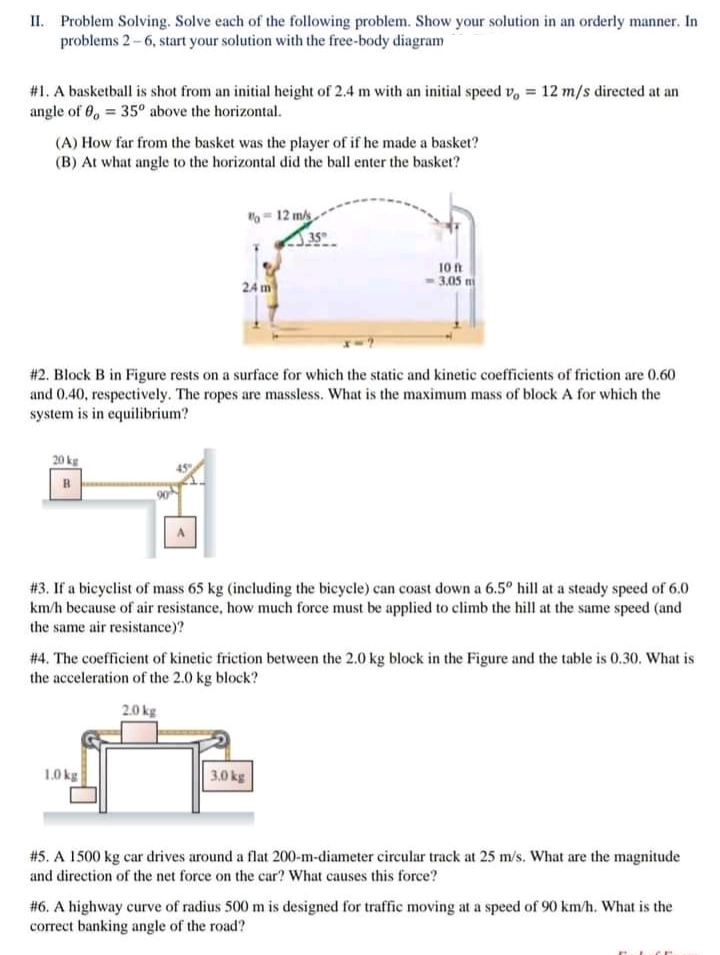II. Problem Solving. Solve each of the following problem. Show your solution in an orderly manner. In problems 2-6, start your solution with the free-body diagram #1. A basketball is shot from an initial height of 2.4 m with an initial speed v, = 12 m/s directed at an angle of 0, = 35° above the horizontal. (A) How far from the basket was the player of if he made a basket? (B) At what angle to the horizontal did the ball enter the basket? - 12 m/s 35 10 ft 24 m 3.05 m #2. Block B in Figure rests on a surface for which the static and kinetic coefficients of friction are 0.60 and 0.40, respectively. The ropes are massless. What is the maximum mass of block A for which the system is in equilibrium? 20 kg # 3. If a bicyclist of mass 65 kg (including the bicycle) can coast down a 6.5° hill at a steady speed of 6.0 km/h because of air resistance, how much force must be applied to climb the hill at the same speed (and the same air resistance)? # 4. The coefficient of kinetic friction between the 2.0 kg block in the Figure and the table is 0.30. What is the acceleration of the 2.0 kg block?
II. Problem Solving. Solve each of the following problem. Show your solution in an orderly manner. In problems 2-6, start your solution with the free-body diagram #1. A basketball is shot from an initial height of 2.4 m with an initial speed v, = 12 m/s directed at an angle of 0, = 35° above the horizontal. (A) How far from the basket was the player of if he made a basket? (B) At what angle to the horizontal did the ball enter the basket? - 12 m/s 35 10 ft 24 m 3.05 m #2. Block B in Figure rests on a surface for which the static and kinetic coefficients of friction are 0.60 and 0.40, respectively. The ropes are massless. What is the maximum mass of block A for which the system is in equilibrium? 20 kg # 3. If a bicyclist of mass 65 kg (including the bicycle) can coast down a 6.5° hill at a steady speed of 6.0 km/h because of air resistance, how much force must be applied to climb the hill at the same speed (and the same air resistance)? # 4. The coefficient of kinetic friction between the 2.0 kg block in the Figure and the table is 0.30. What is the acceleration of the 2.0 kg block?
College Physics
11th Edition
ISBN:9781305952300
Author:Raymond A. Serway, Chris Vuille
Publisher:Raymond A. Serway, Chris Vuille
Chapter1: Units, Trigonometry. And Vectors
Section: Chapter Questions
Problem 1CQ: Estimate the order of magnitude of the length, in meters, of each of the following; (a) a mouse, (b)...
Related questions
Question
Please help me answer number 6 with complete solution

Transcribed Image Text:II. Problem Solving. Solve each of the following problem. Show your solution in an orderly manner. In
problems 2-6, start your solution with the free-body diagram
#1. A basketball is shot from an initial height of 2.4 m with an initial speed v, = 12 m/s directed at an
angle of 0, = 35° above the horizontal.
(A) How far from the basket was the player of if he made a basket?
(B) At what angle to the horizontal did the ball enter the basket?
- 12 m/s
35
10 ft
24 m
3.05 m
#2. Block B in Figure rests on a surface for which the static and kinetic coefficients of friction are 0.60
and 0.40, respectively. The ropes are massless. What is the maximum mass of block A for which the
system is in equilibrium?
20 kg
#3. If a bicyclist of mass 65 kg (including the bicycle) can coast down a 6.5° hill at a steady speed of 6.0
km/h because of air resistance, how much force must be applied to climb the hill at the same speed (and
the same air resistance)?
# 4. The coefficient of kinetic friction between the 2.0 kg block in the Figure and the table is 0.30. What is
the acceleration of the 2.0 kg block?
2.0 kg
1.0 kg
3.0 kg
#5. A 1500 kg car drives around a flat 200-m-diameter circular track at 25 m/s. What are the magnitude
and direction of the net force on the car? What causes this force?
#6. A highway curve of radius 500 m is designed for traffic moving at a speed of 90 km/h. What is the
correct banking angle of the road?
Expert Solution
This question has been solved!
Explore an expertly crafted, step-by-step solution for a thorough understanding of key concepts.
Step by step
Solved in 2 steps with 2 images

Recommended textbooks for you

College Physics
Physics
ISBN:
9781305952300
Author:
Raymond A. Serway, Chris Vuille
Publisher:
Cengage Learning

University Physics (14th Edition)
Physics
ISBN:
9780133969290
Author:
Hugh D. Young, Roger A. Freedman
Publisher:
PEARSON

Introduction To Quantum Mechanics
Physics
ISBN:
9781107189638
Author:
Griffiths, David J., Schroeter, Darrell F.
Publisher:
Cambridge University Press

College Physics
Physics
ISBN:
9781305952300
Author:
Raymond A. Serway, Chris Vuille
Publisher:
Cengage Learning

University Physics (14th Edition)
Physics
ISBN:
9780133969290
Author:
Hugh D. Young, Roger A. Freedman
Publisher:
PEARSON

Introduction To Quantum Mechanics
Physics
ISBN:
9781107189638
Author:
Griffiths, David J., Schroeter, Darrell F.
Publisher:
Cambridge University Press

Physics for Scientists and Engineers
Physics
ISBN:
9781337553278
Author:
Raymond A. Serway, John W. Jewett
Publisher:
Cengage Learning

Lecture- Tutorials for Introductory Astronomy
Physics
ISBN:
9780321820464
Author:
Edward E. Prather, Tim P. Slater, Jeff P. Adams, Gina Brissenden
Publisher:
Addison-Wesley

College Physics: A Strategic Approach (4th Editio…
Physics
ISBN:
9780134609034
Author:
Randall D. Knight (Professor Emeritus), Brian Jones, Stuart Field
Publisher:
PEARSON